2016 SUBARU BRZ battery
[x] Cancel search: batteryPage 402 of 490
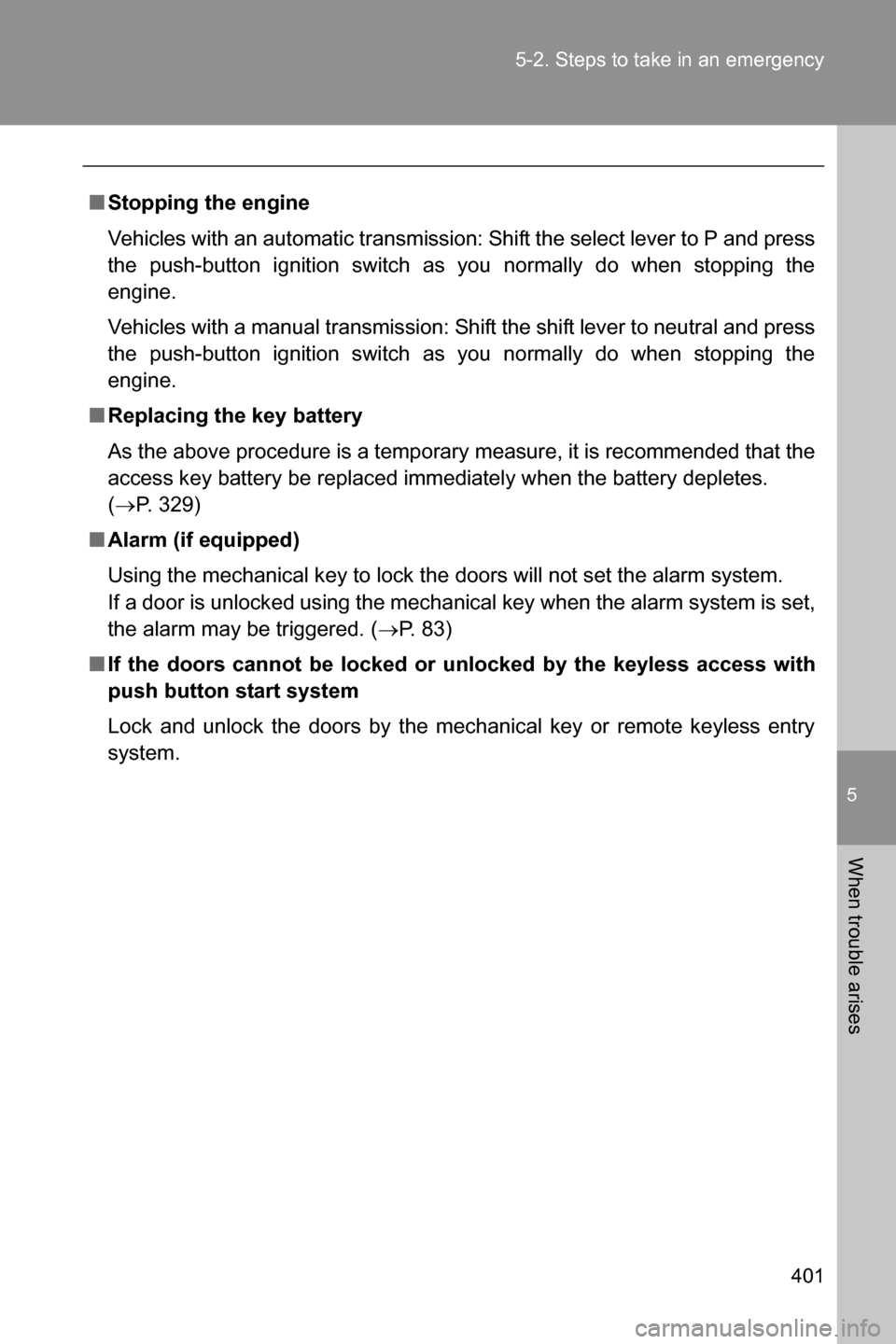
5
When trouble arises
401 5-2. Steps to take in an emergency
■Stopping the engine
Vehicles with an automatic transmission: Shift the select lever to P and press
the push-button ignition switch as you normally do when stopping the
engine.
Vehicles with a manual transmission: Shift the shift lever to neutral and press
the push-button ignition switch as you normally do when stopping the
engine.
■Replacing the key battery
As the above procedure is a temporary measure, it is recommended that the
access key battery be replaced immediately when the battery depletes.
(�oP. 329)
■Alarm (if equipped)
Using the mechanical key to lock the doors will not set the alarm system.
If a door is unlocked using the mechanical key when the alarm system is set,
the alarm may be triggered. (�oP. 8 3 )
■If the doors cannot be locked or unlocked by the keyless access with
push button start system
Lock and unlock the doors by the mechanical key or remote keyless entry
system.
Page 403 of 490
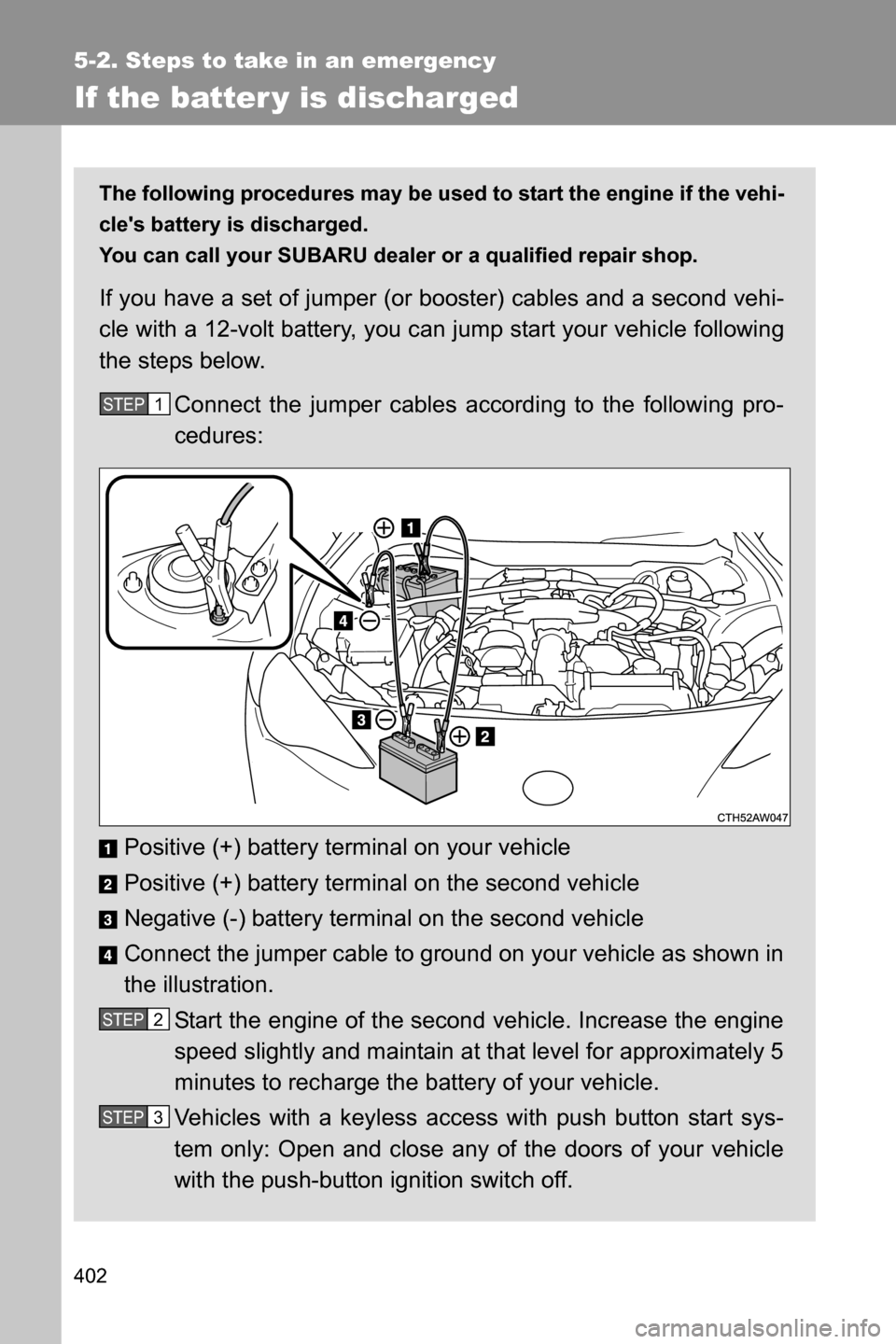
402
5-2. Steps to take in an emergency
If the batter y is discharged
The following procedures may be used to start the engine if the vehi-
cle's battery is discharged.
You can call your SUBARU dealer or a qualified repair shop.
If you have a set of jumper (or booster) cables and a second vehi-
cle with a 12-volt battery, you can jump start your vehicle following
the steps below.
Connect the jumper cables according to the following pro-
cedures:
Positive (+) battery terminal on your vehicle
Positive (+) battery terminal on the second vehicle
Negative (-) battery terminal on the second vehicle
Connect the jumper cable to ground on your vehicle as shown in
the illustration.
Start the engine of the second vehicle. Increase the engine
speed slightly and maintain at that level for approximately 5
minutes to recharge the battery of your vehicle.
Vehicles with a keyless access with push button start sys-
tem only: Open and close any of the doors of your vehicle
with the push-button ignition switch off.
STEP 1
STEP 2
STEP 3
Page 405 of 490
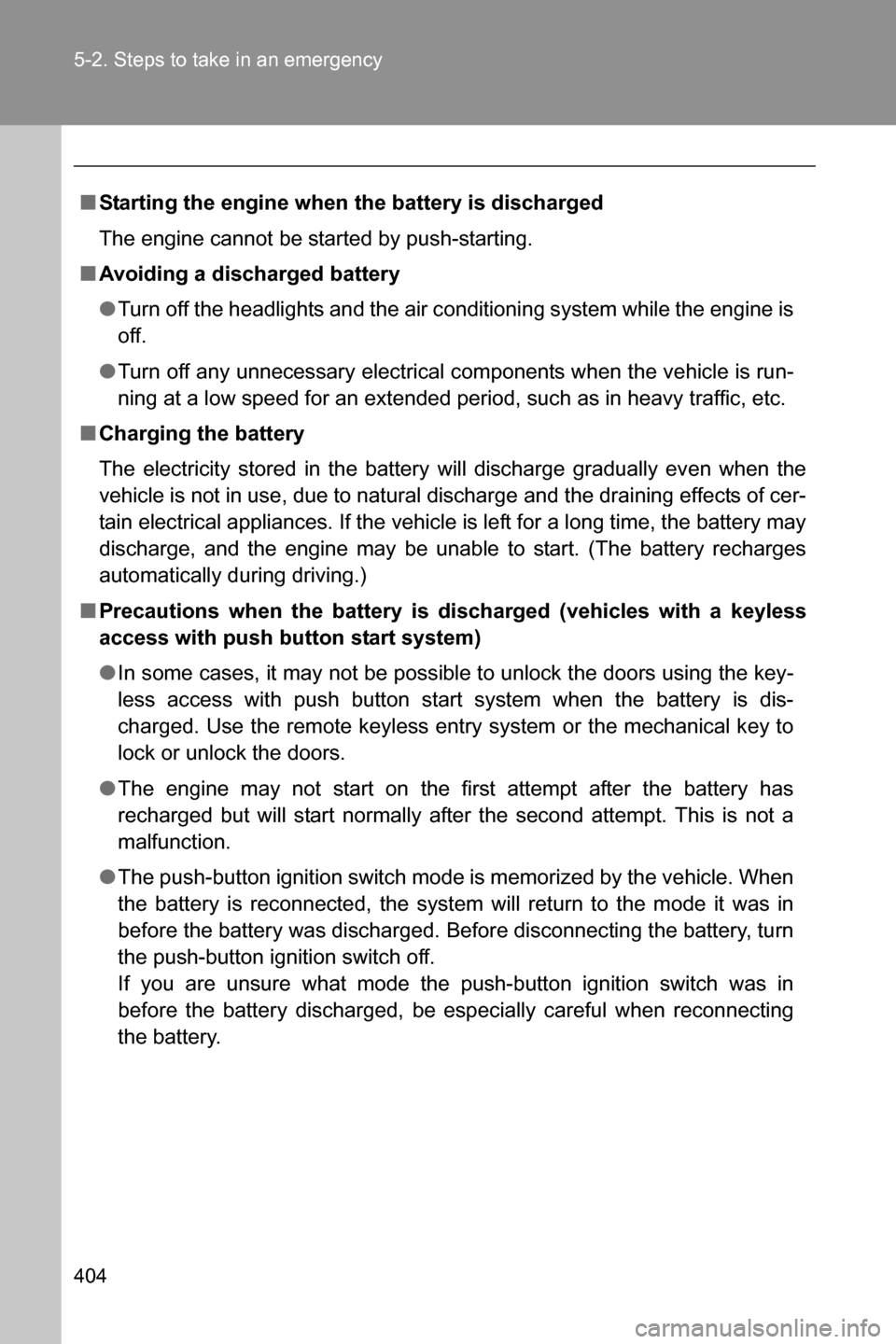
404 5-2. Steps to take in an emergency
■Starting the engine when the battery is discharged
The engine cannot be started by push-starting.
■Avoiding a discharged battery
●Turn off the headlights and the air conditioning system while the engine is
off.
●Turn off any unnecessary electrical components when the vehicle is run-
ning at a low speed for an extended period, such as in heavy traffic, etc.
■Charging the battery
The electricity stored in the battery will discharge gradually even when the
vehicle is not in use, due to natural discharge and the draining effects of cer-
tain electrical appliances. If the vehicle is left for a long time, the battery may
discharge, and the engine may be unable to start. (The battery recharges
automatically during driving.)
■Precautions when the battery is discharged (vehicles with a keyless
access with push button start system)
●In some cases, it may not be possible to unlock the doors using the key-
less access with push button start system when the battery is dis-
charged. Use the remote keyless entry system or the mechanical key to
lock or unlock the doors.
●The engine may not start on the first attempt after the battery has
recharged but will start normally after the second attempt. This is not a
malfunction.
●The push-button ignition switch mode is memorized by the vehicle. When
the battery is reconnected, the system will return to the mode it was in
before the battery was discharged. Before disconnecting the battery, turn
the push-button ignition switch off.
If you are unsure what mode the push-button ignition switch was in
before the battery discharged, be especially careful when reconnecting
the battery.
Page 406 of 490
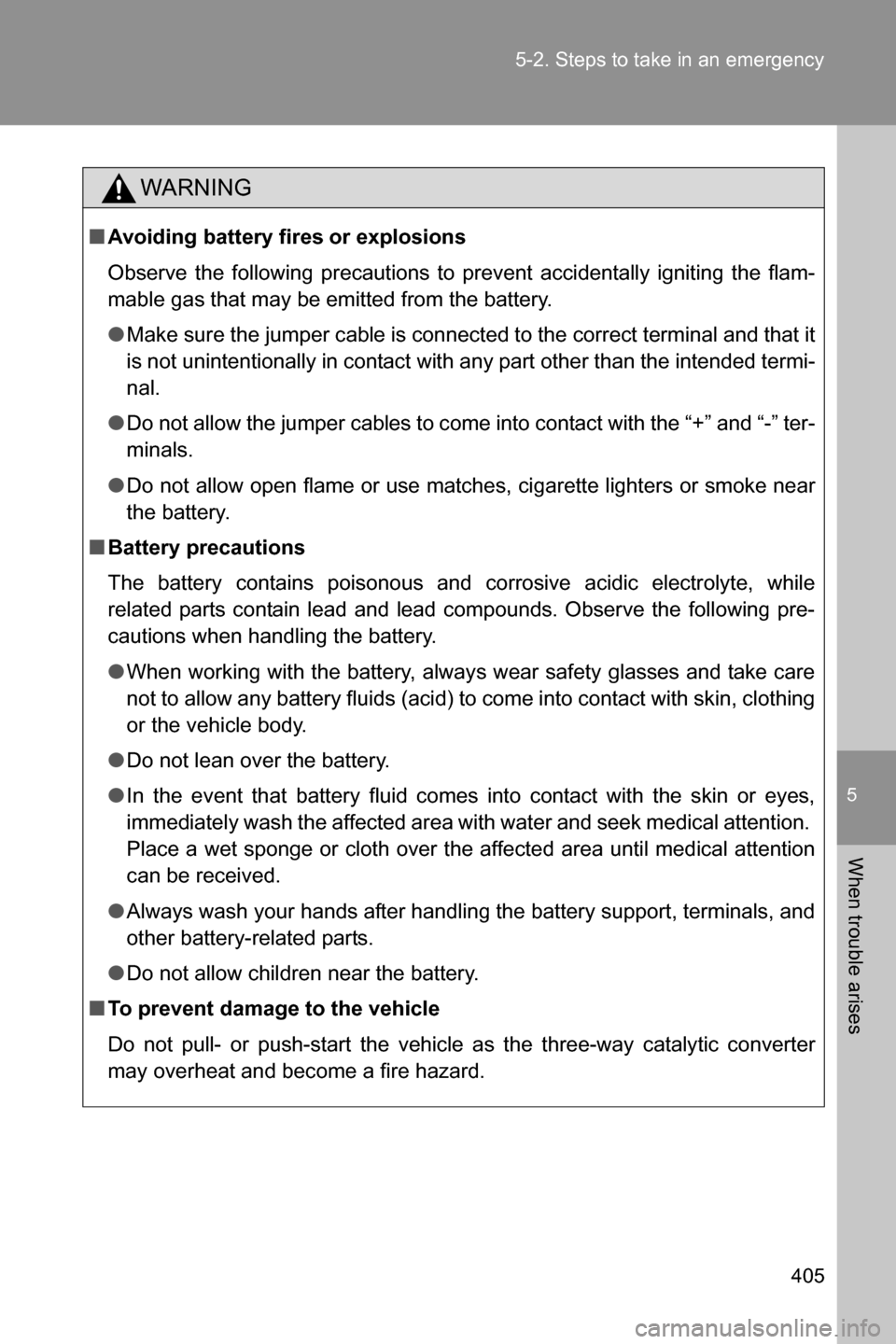
5
When trouble arises
405 5-2. Steps to take in an emergency
WARNING
■Avoiding battery fires or explosions
Observe the following precautions to prevent accidentally igniting the flam-
mable gas that may be emitted from the battery.
●Make sure the jumper cable is connected to the correct terminal and that it
is not unintentionally in contact with any part other than the intended termi-
nal.
●Do not allow the jumper cables to come into contact with the “+” and “-” ter-
minals.
●Do not allow open flame or use matches, cigarette lighters or smoke near
the battery.
■Battery precautions
The battery contains poisonous and corrosive acidic electrolyte, while
related parts contain lead and lead compounds. Observe the following pre-
cautions when handling the battery.
●When working with the battery, always wear safety glasses and take care
not to allow any battery fluids (acid) to come into contact with skin, clothing
or the vehicle body.
●Do not lean over the battery.
●In the event that battery fluid comes into contact with the skin or eyes,
immediately wash the affected area with water and seek medical attention.
Place a wet sponge or cloth over the affected area until medical attention
can be received.
●Always wash your hands after handling the battery support, terminals, and
other battery-related parts.
●Do not allow children near the battery.
■To prevent damage to the vehicle
Do not pull- or push-start the vehicle as the three-way catalytic converter
may overheat and become a fire hazard.
Page 422 of 490
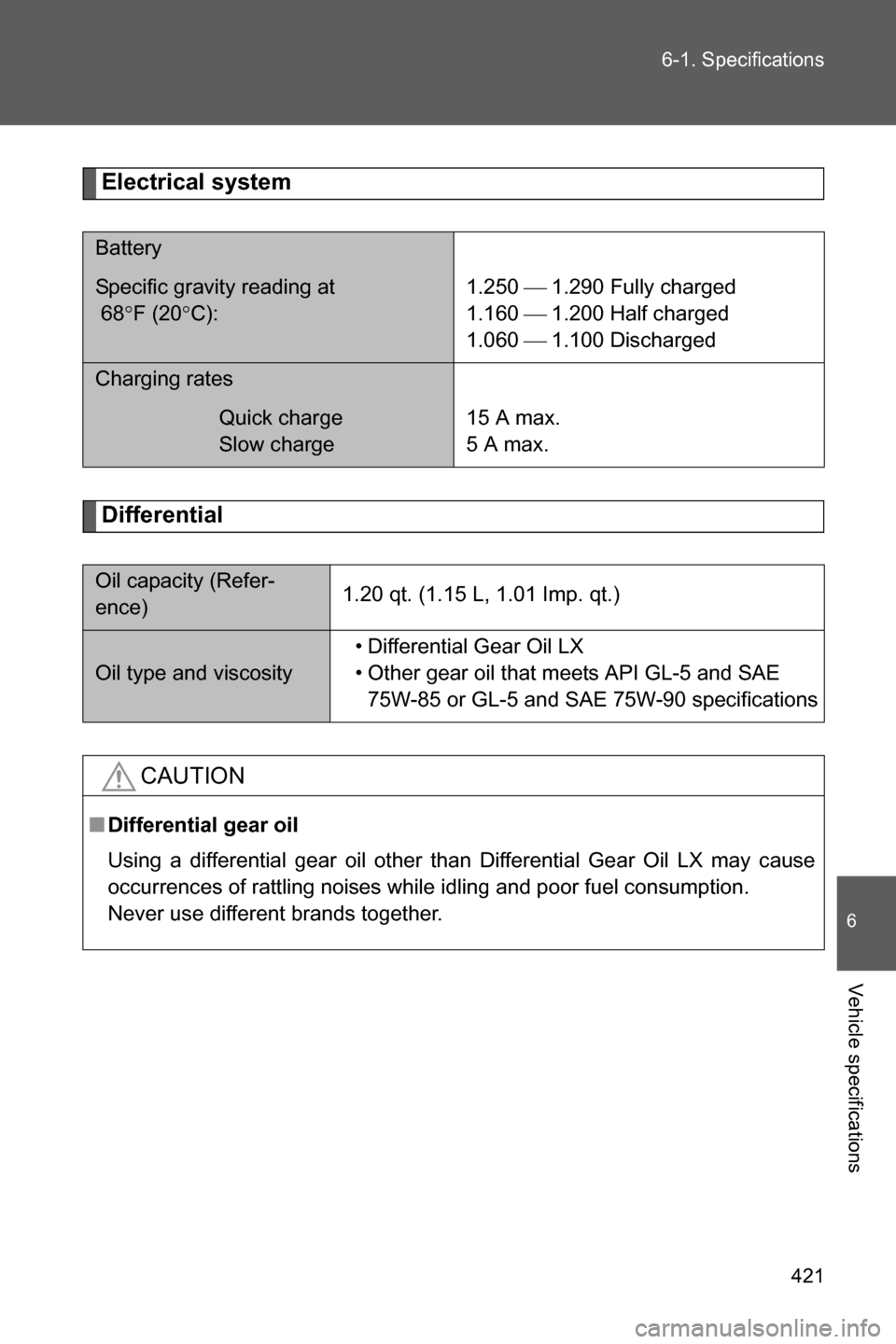
421 6-1. Specifications
6
Vehicle specifications
Electrical system
Differential
Battery
Specific gravity reading at
68�qF (20�qC):1.250� 1.290 Fully charged
1.160� 1.200 Half charged
1.060� 1.100 Discharged
Charging rates
Quick charge
Slow charge15 A max.
5 A max.
Oil capacity (Refer-
ence)1.20 qt. (1.15 L, 1.01 Imp. qt.)
Oil type and viscosity• Differential Gear Oil LX
• Other gear oil that meets API GL-5 and SAE
75W-85 or GL-5 and SAE 75W-90 specifications
CAUTION
■Differential gear oil
Using a differential gear oil other than Differential Gear Oil LX may cause
occurrences of rattling noises while idling and poor fuel consumption.
Never use different brands together.
Page 438 of 490
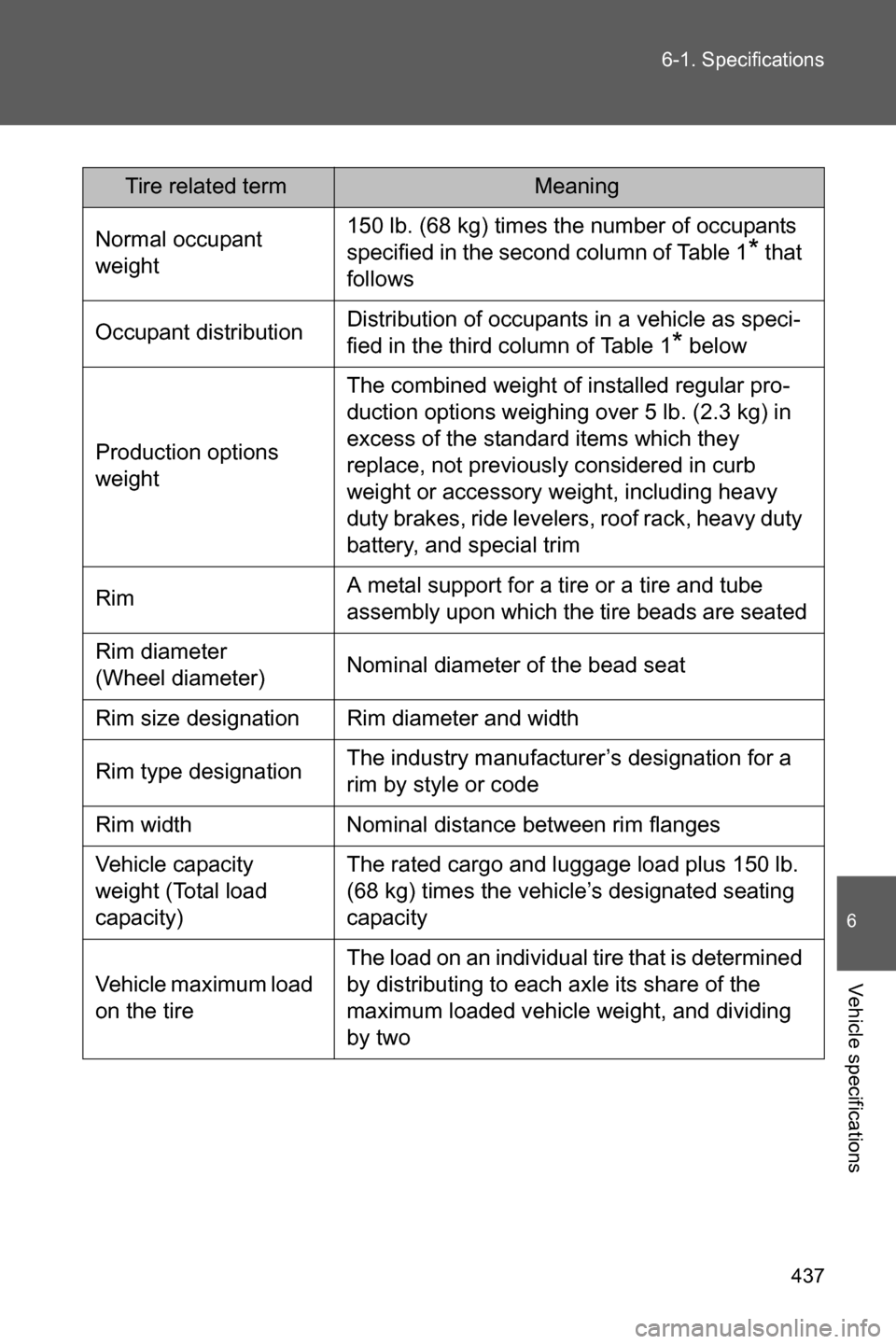
437 6-1. Specifications
6
Vehicle specifications
Tire related termMeaning
Normal occupant
weight150 lb. (68 kg) times the number of occupants
specified in the second column of Table 1
* that
follows
Occupant distributionDistribution of occupants in a vehicle as speci-
fied in the third column of Table 1
* below
Production options
weightThe combined weight of installed regular pro-
duction options weighing over 5 lb. (2.3 kg) in
excess of the standard items which they
replace, not previously considered in curb
weight or accessory weight, including heavy
duty brakes, ride levelers, roof rack, heavy duty
battery, and special trim
RimA metal support for a tire or a tire and tube
assembly upon which the tire beads are seated
Rim diameter
(Wheel diameter)Nominal diameter of the bead seat
Rim size designation Rim diameter and width
Rim type designationThe industry manufacturer’s designation for a
rim by style or code
Rim width Nominal distance between rim flanges
Vehicle capacity
weight (Total load
capacity)The rated cargo and luggage load plus 150 lb.
(68 kg) times the vehicle’s designated seating
capacity
Vehicle maximum load
on the tireThe load on an individual tire that is determined
by distributing to each axle its share of the
maximum loaded vehicle weight, and dividing
by two
Page 476 of 490

475
Alphabetical index
Alphabetical index
A/C .................................... 238, 245
ABS........................................... 217
Access key
If the access key does
not operate properly........... 398
Air conditioning filter.............. 326
Air conditioning system
Air conditioning filter ............. 326
Automatic air conditioning
system................................ 245
Manual air conditioning
system................................ 238
Airbags
Airbag operating
conditions................... 104, 112
Airbag precautions for
your child............................ 118
Airbag warning light .............. 369
Curtain airbag
operating conditions........... 112
Curtain airbag
precautions ........................ 118
Front passenger occupant
detection system ................ 124
General airbag
precautions ........................ 118
Locations of airbags ............... 89
Modification and
disposal of airbags ............. 121
Proper driving
posture ......................... 87, 118
Side airbag operating
conditions........................... 112
Side airbag
precautions ........................ 118
Side and curtain airbags
operating conditions........... 112
Side and curtain airbags
precautions ........................ 118
SRS airbags ........................... 89
Alarm .......................................... 83Anti-lock brake system............217
Audio input ...............................256
Audio system
Audio input ............................256
AUX port................................256
iPod .......................................256
Portable music player............256
USB memory .........................256
USB port................................256
Automatic air conditioning
system ....................................245
Automatic light
control system .......................202
Automatic transmission
Automatic transmission .........174
If the select lever cannot be
shifted from P......................396
Manual mode ........................177
Mode select switch ................176
AUX port ...................................256
Back-up lights
Replacing light bulbs .............342
Wattage .................................425
Battery
Checking ...............................306
If the vehicle has a
discharged battery ..............402
Preparing and checking
before winter .......................229
Bottle holders ...........................262
Brake
Fluid ......................................304
Parking brake ........................185
Brake assist..............................217
Break-in tips .............................151
Brightness control
Instrument panel light
control .................................191A
B
Page 477 of 490

476 Alphabetical index
Care
Alcantara®............................. 284
Exterior.................................. 276
Interior ................................... 280
Seatbelts ............................... 281
Cargo capacity ......................... 224
Chains ....................................... 231
Child restraint system
Booster seats,
definition ............................. 134
Booster seats,
installation ........................... 138
Convertible seats,
definition ............................. 134
Convertible seats,
installation ........................... 138
Front passenger occupant
detection system .................124
Infant seats,
definition ............................. 134
Infant seats,
installation ........................... 138
Installing CRS with
LATCH anchors .................. 139
Installing CRS with
seatbelts ............................. 141
Installing CRS with
top tether straps .................. 144Child safety
Airbag precautions ................ 118
Battery precautions ....... 309, 405
Child restraint system ........... 134
How your child should
wear the seatbelt .................. 60
Installing child restraints........ 138
Power window lock switch ...... 70
Power window
precautions ........................... 73
Removed key battery
precautions ......................... 332
Seat heater precautions ........ 272
Seatbelt guide ......................... 59
Seatbelt precautions ............... 62
Trunk precautions ................... 48
Cleaning
Alcantara
®............................. 284
Exterior.................................. 276
Interior ................................... 280
Seatbelts ............................... 281
Clock ......................................... 267
Condenser ................................ 304
Console tray ............................. 263
Cooling system
Engine overheating ............... 407
Cruise control .......................... 212
Cup holders .............................. 263
Customizable features ............ 443
C